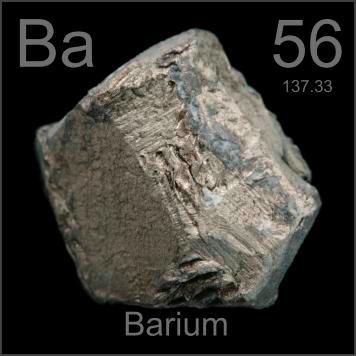Source of the photo
http://gensonscience.wikispaces.com/Barium
Author of the description
Gruiz Katalin

Atomic number
| 56
| Atomic mass
| 137.33 g.mol -1
| Electronegativity
| 0.9
| Density
| 3.5 g.cm-3 at 20°C
| Melting point
| 725 °C
| Boiling point
| 1640 °C
| Vanderwaals radius
| 0.222 nm
| Ionic radius
| 0.135
| Isotopes
| 16
| Electronic shell
| [ Xe ] 6s2
| Energy of first ionisation
| 502.7 kJ.mol -1
| Energy of second ionisation
| 965 kJ.mol -1
| Standard potential
| - 2.90 V
| Discovered by
| Sir Humphrey Davy in 1808
|
|
|
Barium is a silvery-white metal that can be found in the environment, where it exists naturally. It occurs combined with other chemicals, such as sulfur, carbon or oxygen. Ii is very light and its density is half that of iron. Barium oxidizes in air, reacts vigoroulsy with water to form the hydroxide, liberating hydrogen. Barium reacts with almost all the non-metals, forming often poisouning compounds.
Applications
Barium is often used in barium-nickel alloys for spark-plug electrodes an in vacuum tubes as drying and oxygen-removing agent. It is also used in fluorescent lamps: impure barium sulfide phosphoresces after exposure to the light.
Barium compounds are used by the oil and gas industries to make drilling mud. Drilling mud simplifies drilling through rocks by lubricating the drill.
Barium compounds are also used to make paint, bricks, tiles, glass, and rubber. Barium nitrate and clorate give fireworks a green colour.
|
